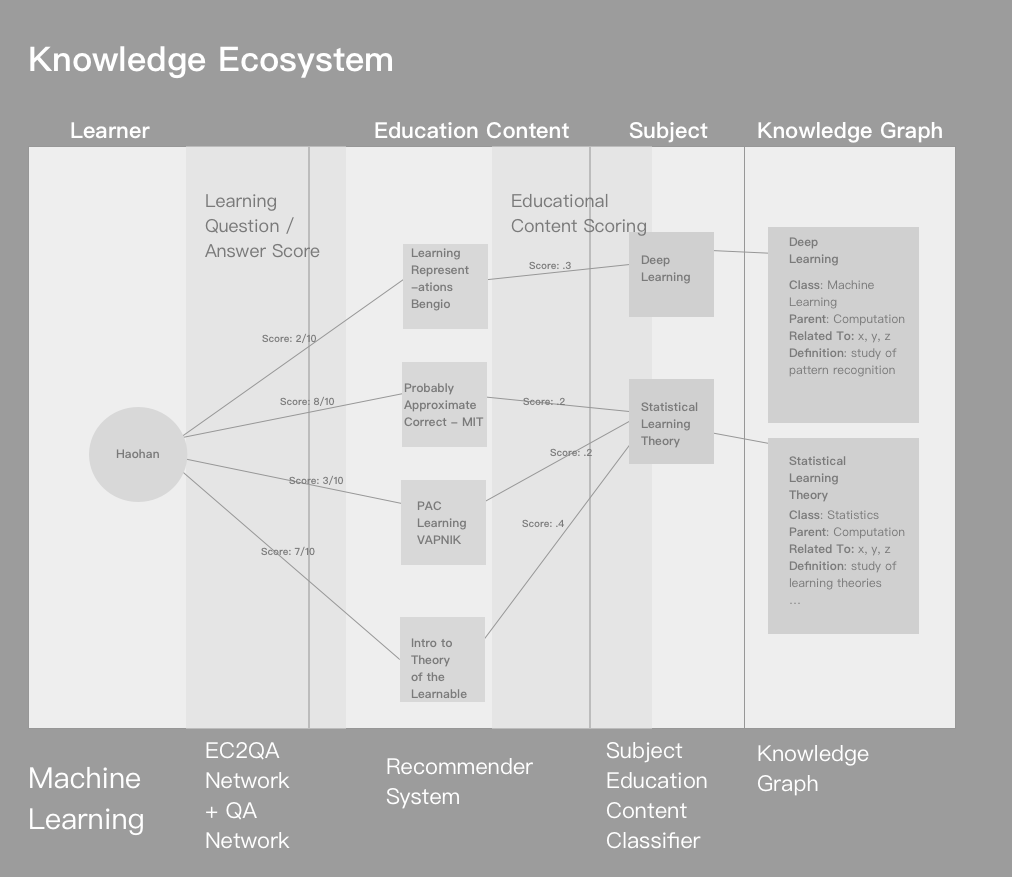2 Primary Concerns
There are 3 main concerns that we will attempt to address in this article about online knowledge acquisition that stands in the way of having an adaptive and reliable knowledge ecosystem. We will attempt to present a system that can sufficiently overcome each of the concerns here and in the implementation section.
There are as follows:
Passive Consumption - most of the online content is viewed passively by the learner and the result of passive consumption is that a learner does not grasp the concepts being taught.
Untested Knowledge - even if the learner was engaged while viewing a piece of educational content their knowledge is untested and therefore it isn’t clear if they’ve mastered the content accurately and in some sense holistically.
Knowledge Representation - even if the learner was engaged (1) and their knowledge was tested (2), simply knowing the counts or types of video they watched doesn’t make their knowledge predictable and useful to others. In fact, even the learner may be unaware of all of what they’ve viewed.
2.1 Passive Consumption and Untested Knowledge
How would such an ecosystem ensure us against passive consumption?
Scenario #1 A learner goes online and begins watching a series on Machine Learning. How do we engage and test a user’s knowledge?
Proposition: Using advances in deep learning, we propose a dual question and answer generation framework given the educational content.
Result: A learner gets a set of questions and multiple choice answers throughout the video. Keeping the user engaged and sharp to ensure they can answer each of the questions.
As you can see, we’ve bundled passive consumption and untested knowledge because our proposed ecosystem approaches both of these by always testing the knowledge.
2.2 Knowledge Ecosystem Example

Knowledge Ecosystem
Given a piece of educational content, our knowledge system will generate a set of questions and answers that theoretically capture the major concepts and facts that the learner should know after viewing a part of the content in whole.
You can imagine watching a Youtube video and after a learner views 15 minutes of an hour-long lecture on Computational Complexity a quiz is presented (i.e. conditioned on the past 15 minutes of video), and the score is recorded. In the future, we would also be able to use the knowledge graph to bring in learner’s existing knowledge in order to generate more complex questions and answers with these priors and the current educational content.
As the first step, our knowledge system would only consider content that is currently in use for now.
2.3 The Problem of Knowledge Representation
Given most learner’s online knowledge acquisition varies and has been invisible up to now, how we can best represent their knowledge?
Scenario #2 A learner has a degree in Public Health, but since graduating, he has been studying machine learning for the last 3 years. The learner now wants to apply to a job that requires the skills in both Health and Machine Learning. How do we represent their traditional and updated knowledge?
This is a tricky problem that goes beyond any given algorithm. The exact design of a knowledge footprint and a knowledge journey has been attempted and we will not cover that in depth here. The proposed system presupposes the design of the knowledge footprint.
There is another problem:
how do we reduce someone’s knowledge (in this case a set of educational content and their respective scores) into a symbol that is representative of his/her current knowledge and could be shared across?
Proposition: We introduce knowledge journeys and the knowledge graph as a way to make sense and structure a learner’s knowledge acquisition. The collective knowledge graph will tell us about the subject the learner is studying and we can use this to compare to others and create a relative comparison.
Result: Reducing a learner’s knowledge journey into a common set of dimensions that make up into their knowledge footprint which would look similar to those with similar journeys.
As a result, the employer, now familiar with the footprints can check the overlap between the current employee’s and a prospective employee’s to support their decision making.